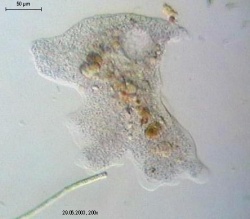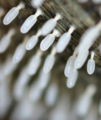Amoebozoa
| Amoebozoa |
|---|

|
| Scientific Classification |
| Classes |
|
The amoebozoa are one of the main groups of amoeboid protozoa, this is also counting the cells that move via internal cytoplasmic flow. The amoebozoa’s pseudopodia are called lobopodia and are long, stretchy, and finger like. Many amoebozoas are unicellular or symbiotes. Most of the unicellular amoebozoa are usual in soil and aquatic environments. The amoebozoa also contain slime molds. Slime molds produce spores and are visible to the naked eye. Many amoebozoa are only 10-20 μm in size, but there are many that can reach much longer lengths. The Amoeba proteus can reach 800 μm in length.
Anatomy
The cell is divided into two different structures. The coarse, inner structure is called the endoplasm and the clear, outer layer is called the ectoplasm. Amoeba also have a distinct anterior and posterior. When the cell moves from place to place, the ectoplasm flows forwards and the endoplasm moves towards the back of the cell around the outside. Amoebas act as a whole pseudopod. A pseudopod is a temporary cytoplasmic protrusion in amoeba and other protozoa used for locomotion and to take up food. Amoebas generally manufacture many clear projections called sub pseudopodia (or determinate pseudopodia). The sub pseudopodia have a definite length and are not directly concerned in locomotion.[1]
Life Cycle
Amoebozoa begin as cysts. These cysts are created when there is very little food and are distributed through the air. The cysts enter into a completely different environment and begin to establish themselves in that area. These cysts grow to become amoebozoas and once that amoebozoa is about to die off it sends out new cysts to go and populate brand new areas of their environment. Cell division, to create new cysts, usually occurs through mitosis. Mitosis is where the daughter nucleus obtains one replicate of each chromosome. Reproduction also occurs through nuclear fusion.[2]
Ecology
The main process for acquiring nutrition is through phagocytosis. Phagocytosis is the intake of a smaller cell or cell fragment, a microorganism, or unfamiliar objects through the process in which the local infolding of a cell's membrane and the extension of its cytoplasm around the fold until the object has been completely encased by the cell membrane and the formation of a vacuole.[3] After the food has been sealed in a vacuole, the particles are digested and absorbed. Some amoebae possess a posterior bulb called a uroid. The uroid collects waste and occasionally detaches from the rest of the cell. Most species create cysts (a closed membranous sac that contains fluid or semisolid material) when there is very little food which are then sent out through the air and are then established in new environments.[4]
Gallery
Slime mold
(Diachea leucopodia)
Class MycetozoaAmebic colitis: Amoebic dysentery - inflammation of the intestine with ulcers in the colon due to infection with an amoeba (Entamoeba histolytica) Class: Archamoebae.


